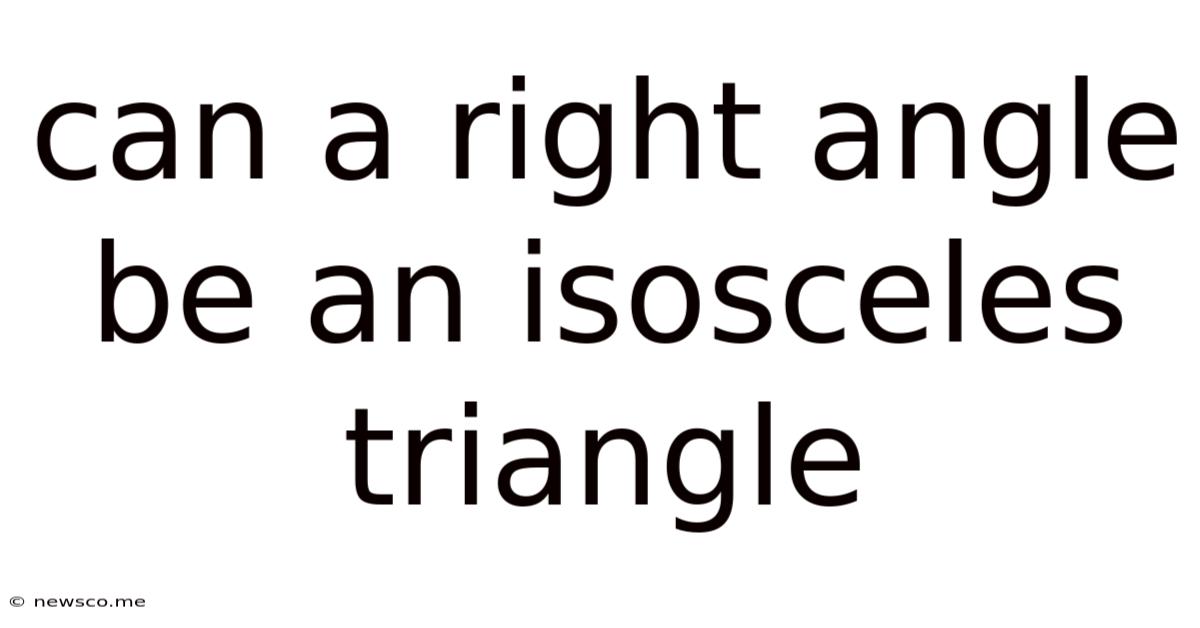Can A Right Angle Be An Isosceles Triangle
News Co
Mar 16, 2025 · 5 min read

Table of Contents
Can a Right Angle Be an Isosceles Triangle? Exploring the Geometry
The question of whether a right angle can be an isosceles triangle is a fascinating one that delves into the fundamental principles of geometry. While seemingly simple, it requires a thorough understanding of the definitions and properties of both right-angled triangles and isosceles triangles. This article will explore this question in detail, clarifying the concepts and providing a comprehensive answer.
Understanding Key Definitions: Right-Angled and Isosceles Triangles
Before diving into the core question, let's clearly define the key terms:
Right-Angled Triangle: A right-angled triangle is a triangle that contains one right angle (90 degrees). The side opposite the right angle is called the hypotenuse, and it's always the longest side in the triangle. The other two sides are called legs or cathetus.
Isosceles Triangle: An isosceles triangle is a triangle that has at least two sides of equal length. These equal sides are called legs, and the angle between them is called the vertex angle. The third side is called the base.
Analyzing the Possibility: Can a Right-Angled Triangle be Isosceles?
The question at hand isn't whether a right angle exists in an isosceles triangle (it certainly can), but rather whether a triangle can simultaneously possess both the properties of having a right angle and having at least two equal sides.
Let's consider the possibilities:
-
If a triangle has a right angle (90 degrees), the other two angles must add up to 90 degrees (180 degrees total in any triangle). This is a fundamental property of triangles.
-
If the triangle is also isosceles, at least two of its angles must be equal.
Now, let's explore the scenarios:
-
Scenario 1: The two equal angles are the non-right angles. If the two equal angles are the non-right angles, and they add up to 90 degrees, then each of these angles must be 45 degrees (90 degrees / 2 = 45 degrees). This forms a 45-45-90 triangle, a specific type of right-angled isosceles triangle. This is a perfectly valid and commonly encountered geometric shape. Therefore, yes, a right-angled triangle can be isosceles in this case.
-
Scenario 2: The right angle is one of the equal angles. This scenario is impossible. A triangle cannot have two 90-degree angles; the sum of angles in a triangle always equals 180 degrees. Therefore, this scenario is invalid.
The 45-45-90 Triangle: A Detailed Look
The 45-45-90 triangle, also known as the isosceles right-angled triangle, holds a special place in geometry due to its unique properties. Let's delve into its characteristics:
-
Angles: It possesses angles of 45, 45, and 90 degrees.
-
Sides: The two legs (sides adjacent to the right angle) are equal in length. The hypotenuse (side opposite the right angle) is √2 times the length of each leg. This ratio (1:1:√2) is a defining characteristic of this type of triangle.
-
Properties: Besides being both right-angled and isosceles, it displays several other interesting properties, making it frequently used in various geometric proofs and constructions. Its symmetry makes it especially useful.
-
Applications: The 45-45-90 triangle appears frequently in various fields, including:
-
Trigonometry: Its simple angle measures make it ideal for demonstrating trigonometric ratios.
-
Engineering: It is used in construction and design due to its stability and predictable dimensions.
-
Computer Graphics: The triangle's properties are applied in various algorithms and simulations.
-
Art and Design: Its symmetrical nature makes it aesthetically pleasing and is used in creating balanced and harmonious designs.
-
Proof of Existence: Constructing a 45-45-90 Triangle
We can prove the existence of a right-angled isosceles triangle through a simple construction:
-
Start with a square: Draw a square ABCD.
-
Draw a diagonal: Draw a diagonal line connecting vertices A and C.
-
Two congruent triangles: The diagonal AC divides the square into two congruent right-angled triangles, namely triangle ABC and triangle ADC.
-
Isosceles property: In each triangle (ABC and ADC), sides AB and BC (or AD and DC) are equal because they are sides of a square. Therefore, both triangles are isosceles.
-
Right angle: Both triangles contain a right angle at vertex B (or D).
This construction clearly demonstrates that a right-angled isosceles triangle (45-45-90 triangle) does exist.
Addressing Common Misconceptions
It's crucial to address some common misunderstandings surrounding this topic:
-
Confusing Right Angle with Isosceles: A right angle is simply a 90-degree angle. Isosceles refers to the lengths of the sides. These are distinct properties. A triangle can have a right angle without being isosceles, and an isosceles triangle can exist without a right angle.
-
Assuming Only One Type of Isosceles Triangle: Many people mistakenly think that an isosceles triangle can only be one specific shape. It's important to remember that there's a whole family of isosceles triangles, varying in the measure of their angles. The 45-45-90 triangle is just one example.
Conclusion: The Definitive Answer
In conclusion, a right angle can be part of an isosceles triangle. Specifically, the 45-45-90 triangle perfectly fulfills both conditions – it possesses a right angle and has two equal sides. This specific type of triangle is not just a theoretical concept but a fundamental geometric shape with numerous practical applications. Understanding the properties of right-angled and isosceles triangles is key to grasping this seemingly simple yet insightful geometric relationship. The existence of the 45-45-90 triangle provides a clear and definitive "yes" to the central question.
Latest Posts
Related Post
Thank you for visiting our website which covers about Can A Right Angle Be An Isosceles Triangle . We hope the information provided has been useful to you. Feel free to contact us if you have any questions or need further assistance. See you next time and don't miss to bookmark.